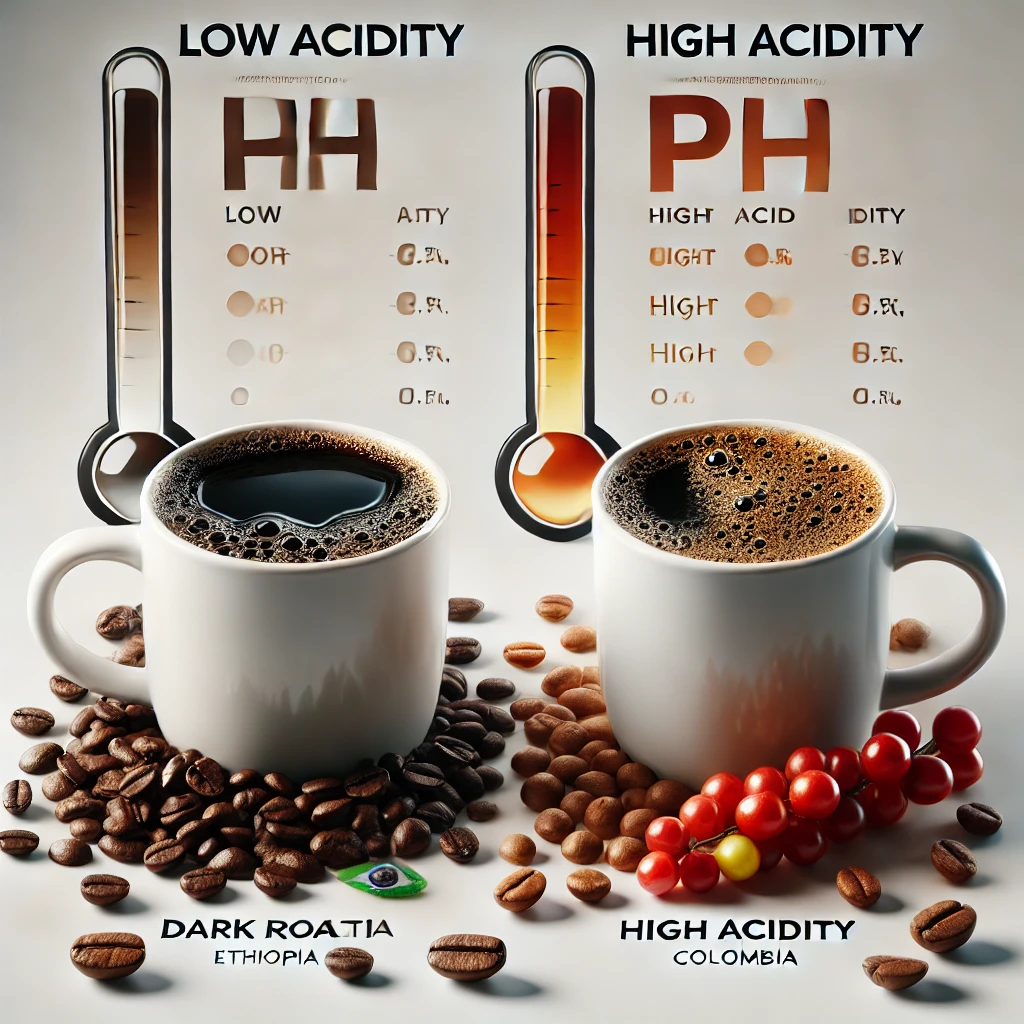Coffee acidity is one of the most important factors influencing flavor, taste, and overall coffee experience. Some coffees have a bright, citrusy acidity, while others are smoother and less tangy. But what exactly causes coffee to be acidic, and how can you control it?
In this guide, we’ll break down the science of coffee acidity, why it matters, and how to adjust it to match your taste preferences.
1. What Is Coffee Acidity?
Acidity in coffee refers to the sharp, bright, and tangy flavors present in the brew. It’s not the same as pH acidity (which measures how acidic a substance is), but rather the perceived taste.
🔹 High-acidity coffees often have fruity, citrusy, or wine-like flavors.
🔹 Low-acidity coffees taste smoother, richer, and sometimes more chocolatey or nutty.
pH scale of coffee:
- Coffee has a pH of around 4.5 to 5.0, making it less acidic than orange juice (pH ~3.5) but more acidic than milk (pH ~6.5).
2. What Causes Coffee Acidity?
Several factors influence the acidity level of coffee:
A) Coffee Bean Type
🔹 Arabica beans have higher acidity and more complex flavors.
🔹 Robusta beans are lower in acidity but have a stronger, more bitter taste.
B) Growing Elevation
🔹 High-altitude coffee (above 1,200m) – More acidity, brighter flavors.
🔹 Low-altitude coffee (below 1,200m) – Less acidity, more earthy notes.
C) Roasting Level
🔥 Light roast: Higher acidity, fruity and floral notes.
🔥 Medium roast: Balanced acidity, smooth body.
🔥 Dark roast: Low acidity, more bitterness and caramelized flavors.
D) Brewing Method
☕ Cold brew – Less acidic due to long steeping time.
☕ Espresso – Moderate acidity due to fast extraction.
☕ Pour-over (V60, Chemex) – Higher acidity because of slow extraction.
E) Water Quality
- Hard water (high minerals) – Reduces acidity, making coffee taste flat.
- Soft water (low minerals) – Enhances acidity, making coffee taste brighter.
3. How to Reduce Coffee Acidity
If you find coffee too acidic, here are ways to reduce it:
✔️ Choose Dark Roast Coffee – Roasting longer breaks down acidic compounds.
✔️ Brew with Cold Water – Cold brew coffee has about 70% less acidity than hot coffee.
✔️ Use Low-Acidity Coffee Beans – Brazilian, Sumatra, and Mexican coffees tend to be lower in acidity.
✔️ Add Milk or Cream – Dairy neutralizes acids and creates a smoother taste.
✔️ Use Baking Soda (Tiny Amount!) – A pinch of baking soda in coffee can reduce acidity.
4. How to Enhance Coffee Acidity for a Brighter Taste
If you prefer a lively, bright coffee, here’s how to enhance acidity:
✔️ Choose Light Roast Beans – More acidity, floral, and fruity notes.
✔️ Opt for High-Altitude Coffee – Ethiopian, Kenyan, and Colombian beans are naturally acidic.
✔️ Use a Pour-Over Method – This highlights acidity better than espresso or French press.
✔️ Avoid Over-Extracting Coffee – Brewing too long can mute acidity and make coffee bitter.
5. Low-Acidity vs. High-Acidity Coffees: Which One Is Better?
It depends on your taste preferences!
🔹 Choose Low-Acidity Coffee If You:
✔️ Have a sensitive stomach (acid reflux or heartburn).
✔️ Prefer smooth, chocolatey, or nutty flavors.
✔️ Drink cold brew or dark roast coffee.
🔹 Choose High-Acidity Coffee If You:
✔️ Love bright, fruity, or citrusy flavors.
✔️ Enjoy light roasts and pour-over methods.
✔️ Want a more complex, lively coffee experience.
Final Thoughts
Coffee acidity plays a huge role in the flavor experience. Whether you prefer a smooth, low-acid coffee or a bright, tangy cup, understanding what affects acidity helps you customize your brew.
